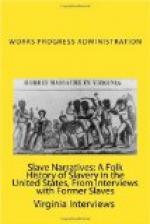From the correspondence and memoranda files of the Washington office of the Federal Writers’ Project the following instructions and criticisms relative to the slave narrative collection, issued from April 1 to September 8, 1937, have been selected. They throw light on the progress of the work, the development of materials and methods, and some of the problems encountered.
1. Copy of Memorandum from George Cronyn to Mrs. Eudora R. Richardson. April 1, 1937.
2. Autograph Memorandum from John A. Lomax to George Cronyn. April 9, 1937.
3. Copy of Memorandum from George Cronyn to Edwin Bjorkman, enclosing a Memorandum from John A. Lomax on “Negro Dialect Suggestions.” April 14, 1937.
4. Mimeographed “Supplementary Instructions #9-E to the American Guide Manual. Folklore. Stories from Ex-Slaves.” April 22, 1937. Prepared by John A. Lomax.
5. Copy of Memorandum from George Cronyn to Edwin Bjorkman. May 3, 1937.
6. Copy of Memorandum from Henry G. Alsberg to State Directors of the Federal Writers’ Project. June 9, 1937.
7. Copy of “Notes by an Editor on Dialect Usage in Accounts by Interviews with Ex-Slaves.” June 20, 1937. Prepared by Sterling A. Brown.
8. Copy of Memorandum from Henry G. Alsberg to State Directors of the Federal Writers’ Project. July 30, 1937.
9. Copy of Memorandum from Henry G. Alsberg to State Directors of the Federal Writers’ Project. September 8, 1937.
[Document 1]
Sent to: North & South Carolina,
Georgia, Alabama,
Louisiana,
Texas, Arkansas, Tennessee,
Kentucky,
Missouri, Mississippi, Okla.
April 1, 1937
Mrs. Eudora R. Richardson, Acting State Director
Federal Writers’ Project, WPA
Rooms 321-4, American Bank Building
Richmond, Virginia
Subj: Folklore
Dear Mrs. Richardson:
We have received from Florida a remarkably interesting collection of autobiographical stories by ex-slaves. Such documentary records by the survivors of a historic period in America are invaluable, both to the student of history and to creative writers.
If a volume of such importance can be assembled we will endeavor to secure its publication. There undoubtedly is material of this sort to be found in your State by making the proper contact through tactful interviewers. While it is desirable to give a running story of the life of each subject, the color and human interest will be greatly enhanced if it is told largely in the words of the person interviewed. The peculiar idiom is often more expressive than a literary account.
We shall be very glad to know if you have undertaken any research of this sort, or plan to do so.
Very truly yours,
George Cronyn
Associate Director
Federal Writers’ Project




